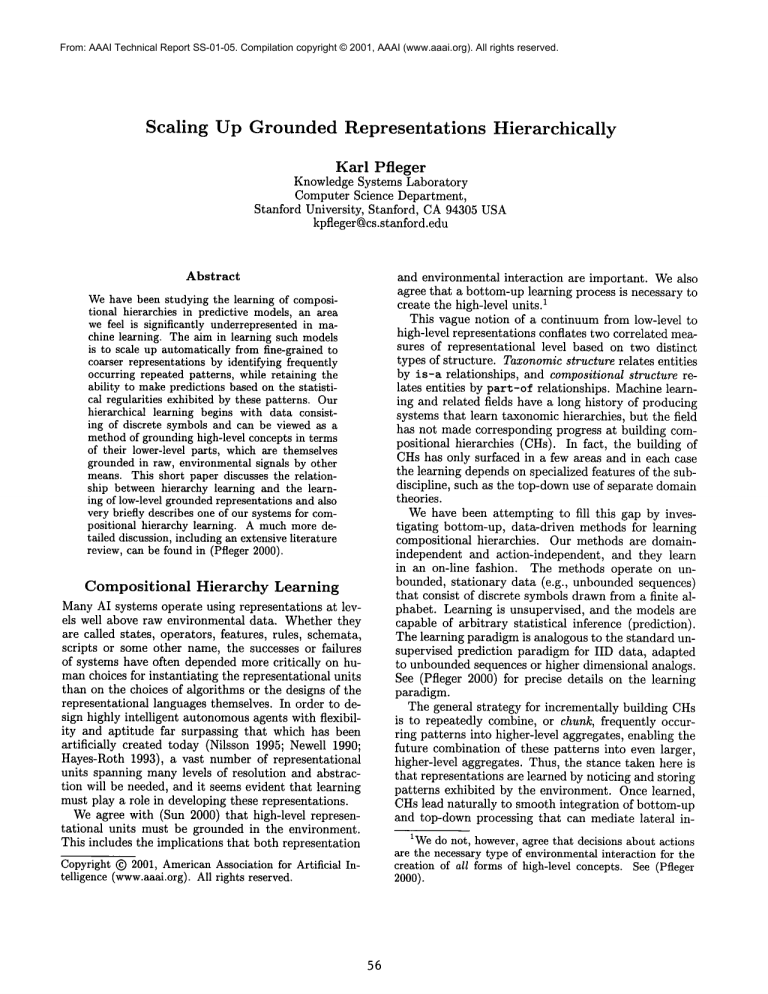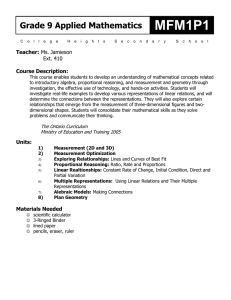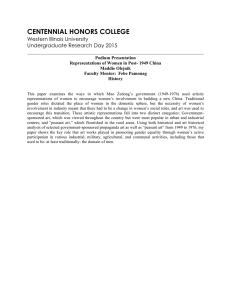
From: AAAI Technical Report SS-01-05. Compilation copyright © 2001, AAAI (www.aaai.org). All rights reserved.
Scaling
Up Grounded Representations
Hierarchically
Karl Pfleger
Knowledge Systems Laboratory
Computer Science Department,
Stanford University, Stanford, CA94305 USA
kpfleger@cs.stanford.edu
Abstract
and environmental interaction are important. Wealso
agree that a bottom-up learning process is necessary to
1create the high-level units.
This vague notion of a continuum from low-level to
high-level representations conflates two correlated measures of representational level based on two distinct
types of structure. Taxonomicstructure relates entities
by is-a relationships, and compositional structure relates entities by part-of relationships. Machinelearning and related fields have a long history of producing
systems that learn taxonomic hierarchies, but the field
has not made corresponding progress at building compositional hierarchies (CHs). In fact, the building
CHshas only surfaced in a few areas and in each case
the learning depends on specialized features of the subdiscipline, such as the top-down use of separate domain
theories.
Wehave been attempting to fill this gap by investigating bottom-up, data-driven methods for learning
compositional hierarchies.
Our methods are domainindependent and action-independent,
and they learn
in an on-line fashion. The methods operate on unbounded, stationary data (e.g., unbounded sequences)
that consist of discrete symbols drawn from a finite alphabet. Learning is unsupervised, and the models are
capable of arbitrary statistical inference (prediction).
The learning paradigm is analogous to the standard unsupervised prediction paradigm for IID data, adapted
to unbounded sequences or higher dimensional analogs.
See (Pfleger 2000) for precise details on the learning
paradigm.
The general strategy for incrementally building CHs
is to repeatedly combine, or chunk, frequently occurring patterns into higher-level aggregates, enabling the
future combination of these patterns into even larger,
higher-level aggregates. Thus, the stance taken here is
that representations are learned by noticing and storing
patterns exhibited by the environment. Once learned,
CHslead naturally to smooth integration of bottom-up
and top-down processing that can mediate lateral in-
Wehave been studying the learning of compositional hierarchies in predictive models, an area
we feel is significantly underrepresented in machine learning. The aim in learning such models
is to scale up automatically from fine-grained to
coarser representations by identifying frequently
occurring repeated patterns, while retaining the
ability to makepredictions basedon the statistica] regularities exhibited by these patterns. Our
hierarchical learning begins with data consisting of discrete symbols and can be viewed as a
methodof groundinghigh-level concepts in terms
of their lower-level parts, which are themselves
groundedin raw, environmental signals by other
means. This short paper discusses the relationship between hierarchy learning and the learning of low-level groundedrepresentations and also
very briefly describes one of our systems for compositional hierarchy learning. A muchmore detailed discussion, including an extensiveliterature
review, can be found in (Pfleger 2000).
Compositional
Hierarchy
Learning
ManyAI systems operate using representations at levels well above raw environmental data. Whether they
are called states, operators, features, rules, schemata,
scripts or some other name, the successes or failures
of systems have often depended more critically on humanchoices for instantiating the representational units
than on the choices of algorithms or the designs of the
representational languages themselves. In order to design highly intelligent autonomousagents with flexibility and aptitude far surpassing that which has been
artificially
created today (Nilsson 1995; Newell 1990;
Hayes-Roth 1993), a vast number of representational
units spanning many levels of resolution and abstraction will be needed, and it seems evident that learning
must play a role in developing these representations.
Weagree with (Sun 2000) that high-level representational units must be grounded in the environment.
This includes the implications that both representation
1Wedo not, however,agree that decisions about actions
are the necessary type of environmentalinteraction for the
creation of all forms of high-level concepts. See (Pfleger
2000).
Copyright © 2001, AmericanAssociation for Artificial Intelligence (www.aaai.org).All rights reserved.
56
ferences, and the chunks themselves can be useful for
memory(Miller 1956; Chase & Simon 1973), communication, planning or reacting, and as features for other
learning tasks.
Unlike most learning systems, the learning is both online and structural (the model grows). The underlying
hypothesis in this work is that compositional hierarchies
are a useful inductive bias for widening models. Froma
bias/variance perspective, building chunks of frequently
occurring patterns by structurally introducing new parameters into the model around the representations of
the new patterns allows models to concentrate more
parameters exactly where there has been more data.
Symbol
Grounding
There is a growing body of work attempting to address
the grounding problem of how representational
units
derive their meanings from the environment by way of
low-level data. The thrust of this work is to makea correspondence between available "raw" data, usually continuous, and newly created "symbolic" data, or higherlevel representations. For example, (Oates, Schmill,
& Cohen 2000) demonstrates clustering of multivariate
time series data derived from mobile robotic sensors.
(Singer & Tishby 1994) provides a way to map continuous handwritten pen trajectories into a sequence of
discrete symbols. Other examples of grounding work include (Coradeschi & Saffiotti 2000) and (Siskind 2000),
but these efforts involve richer representations, which
presents more difficulty for learning.
The important question is not only how to ground
representational units one level above the lowest level,
but how the grounding of representational units at all
levels can be learned. Rather than tying representations at all levels directly to raw environmental data,
it is easier to make the correspondence for high-level
units by tying them to low-level representations, which
are in turn tied to raw environmental data. The ability to learn hierarchical representations in a bottom-up
fashion from the low-level symbolic representations, including specifically the ability to learn hierarchies with
compositional structure, is critical for this representational scaling up.
Thus, discrete symbols from a finite alphabet can
be seen as an entirely reasonable format of input data
for autonomous intelligent agents since work such as
(Oates, Schmill, & Cohen 2000) and (Singer & Tishby
1994) provide explanations of how these symbols can
arise. At the same time, the type of bottom-up hierarchical learning described here provides a plausible
means for representations of increasingly expansive signal patterns to be grounded. These two processes need
not happen in isolation. Sophisticated combinations of
these ideas will allow for interesting interplay between
the mechanisms. Note that these issues span a diverse
set of domains. Another example is provided by the
word learning domain where infants must generate discrete, symbolic representations such as syllables from
57
raw acoustical data, and must also, if you believe models such as those of (Brent &Cartwright 1996) and (Saffran, Aslin, & Newport1996), build higher-level structures out of these symbols to form representations of
words that are thereby also grounded.
Temporally
Extended
Graphical
Models
The two main issues for learning predictive CHsare (a)
how to embody a CHin a representation
that allows
prediction, and (b) how to incrementally grow the
in response to new data. Our work is directly inspired
by the Interactive Activation Model of context effects
in letter perception, or IAM(McClelland & Rumelhart
1981), which structurally encoded a CHof individual
letters and 4-letter words into a symmetric, recurrent
(relaxation-style)
neural network. The basic behavior
of the network was to make inferences about the letters through bottom-up and top-down flow of activation
along part-whole links, but there was no learning.
There have been numerous temporally extended
graphical models, such as Hidden Markov Models, dynamic belief networks (Dean & Kanazawa 1989),
Boltzmann chains (Saul & Jordan 1994), which can represent dependencies of varying width and can make predictions from partial information. Currently, such models cannot incrementally grow new hidden variables,
however, and thus cannot utilize long-term learning to
scale up from low-level to high-level representations.
Our work utilizes a form of temporally extended graphical model that creates new hidden variables within
structures that mimic CHs(like IAM).
Specifically, our network is an undirected graphical
model based on Boltzmann machines (Hinton & Sejnowski 1986). It is thus a symmetric, recurrent neural
network with very similar operation to IAM, and can
be viewed as a direct descendent of IAMaddressing the
lack of learning in that system. The chunking mechanism is based on correlations indicated by large Hebbian weights and is similar in spirit to the mechanism
in Ring’s first system (Ring 1995). Our system is very
briefly described in (Pfleger 1999). A detailed paper
this system is in preparation.
References
Brent, M., and Cartwright, T. 1996. Distributional
regularity and phonotactic constraints are useful for
segmentation. Cognition 61:93-125.
Chase, W., and Simon, H. A. 1973. Perception in
chess. Cognitive Psychology 4.
Coradeschi, S., and Saffiotti, A. 2000. Anchoringsymbols to sensor data: Preliminary report. In Proceedings
of the Seventeenth National Conference on Artificial
Intelligence.
Dean, T., and Kanazawa, K. 1989. A model for reasoning about persistence and causation. Computational
Intelligence 5(3):142-150.
Hayes-Roth, B. 1993. On building integrated cognitive
agents: A review of Allen Newell’s unified theories of
cognition. Artificial Intelligence 59:329-341.
Hinton, G. E., and Sejnowski, T. J. 1986. Learning and relearning in Boltzmann machines. In Parallel Distributed Processing: Explorations in the Microstructures of Cognition, Volume 1: Foundations.
MITPress. chapter 7.
McClelland, J. L., and Rumelhart, D. E. 1981. An
interactive activation modelof context effects in letter perception: Part 1. an account of basic findings.
Psychological Review 88:375-407.
Miller, G. A. 1956. The magic number seven, plus or
minus two: Somelimits of our capacity for processing
information. Psychological Review 63.
Newell, A. 1990. Unified Theories of Cognition. Cambridge, Mass.: Harvard University Press.
Nilsson, N. J. 1995. Eye on the prize. AI Magazine
16(2):9-17.
Oates, T.; Schmill, M.; and Cohen, P. 2000. A method
for clustering the experiences of a mobile robot that
accords with humanjudgements. In Proceedings of the
Seventeenth National Conference on Artificial Intelligence.
Pfleger, K. 1999. Learning compositional hierarchies
by data-driven chunking. In Proceedings of the Sixteenth National Conference on Artificial Intelligence.
(abstract).
Pfleger, K. 2000. Learning predictive compositional
hierarchies. Technical report, KSL, Stanford CS. See
www-cs-students.stanford.edu/-kpfleger/publications/.
Ring, M. 1995. Continual Learning in Reinforcement
Environments. Mfinchen, Wien: R. Oldenbourg Verlag.
Saffran, J.; Aslin, R.; and Newport, E. 1996. Statistical learning by 8-month-old infants. Science 274:19261928.
Saul, L. K., and Jordan, M. I. 1994. Boltzmannchains
and hidden Markov models. In Advances in Neural
Information Processing Systems 7. MITPress.
Singer, Y., and Tishby, N. 1994. Dynamical encoding
of cursive handwriting. Biological Cybernetics 71.
Siskind, J. M. 2000. Visual event classification
via
force dynamics. In Proceedings of the Seventeenth National Conferenceon Artificial Intelligence.
Sun, R. 2000. Symbol grounding: A new look at an
old idea. Philosophical Psychology 13(2).
58







